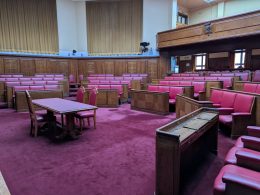For four long months, Putney High Street was caught in a battle it never asked for. What began in late April with squatters slipping into an historic, shuttered pub spiralled into a rolling crisis that saw entire blocks occupied, residents terrorised, businesses shuttered, and authorities exposed as powerless or unwilling to act.
This is the story of how the squatters moved in, how the community fought back, how those that are responsible for dealing with this kind of problem dealt with the crisis (we have marked them out of 10) and how — after months of noise, frustration, and boarded-up shops — the High Street finally won back its freedom.
| APRIL | |
| 24–26 April | Property guardians leave the White Lion as the landlord tries to sell. Immediately, squatters take over, soon spreading into the Boilermaker next door. The crisis begins. |
| MAY | |
| 30 May | Putney.news speaks to the occupiers: they describe moving in after the guardians left, living with working utilities, but knowing eviction will eventually come. |
| JUNE | |
| 7 June | Residents report “eight weeks of hell” with sleepless nights, threats, and damage. Landlord Gordon D’Silva urges police to act, warning of a “dangerous delay”. |
| 25 June | High Court bailiffs repossess the White Lion. But as it is cleared, squatters carry belongings straight into the Boilermaker, showing how displacement works. |
| 27 June | The squatters expand – moving into (breaking into?) the former Kashmir restaurant on Lacy Road, quieter but well-organised, with Section 144 notices taped to the windows. |
| JULY | |
| 31 July | More than a month later, bailiffs and police evict both Kashmir and the Boilermaker in daytime raids – reportedly because of local complaints of drug dealing. Belongings are dumped in Olivette Street, where tents and tarps reappear within hours. |
| AUGUST | |
| 1 August | Police give the Olivette Street encampment a dispersal deadline. Meanwhile, Simmons cocktail bar joins Be At One in closing, leaving more vacant sites. |
| 3–4 August | The weekend it really kicks off. Squatters seize an entire block — Simmons, the Ramna restaurant, and flats above — in a mass occupation. We conclude: “Putney has a squatter problem”. |
| 6 August | The Simmons landlord personally re-enters and secures his site. Crown Properties begins court proceedings for Ramna. K9 security patrols appear at rear entrances. |
| 8 August | More plywood and guards spread across the High Street, while a patchwork of quirky openings keeps trading. |
| 17 August | Strongholds persist: Ramna (and three flats above), Rumble Jungle above Lidl, and Lost Society near the station, despite police holding evidence of forced entry. |
| SEPTEMBER | |
| 5 September | Legal pressure tightens: sealed court papers appear on Ramna’s door. The interior looks more entrenched than ever. Lost Society now displays a LASPO notice. |
| 8 September | The breakthrough — Clearances sweep the Ramna block, Rumble Jungle, and Lost Society. For the first time since April, the High Street is squatter-free. A small camp appears in the rear courtyard hours later, but Putney has won back its main street. |

Who Did Well, Who Did Poorly
| Wandsworth Council | 2/10 |
| The clear loser. While investing heavily in High Streets in Tooting, Clapham Junction and Wandsworth Town, the Council has ignored Putney’s crises. Despite repeat pleas, it left landlords to fend for themselves. Only after a huge public outcry over the Olivette Street encampment did the CEO briefly appear on the High Street — an intervention whose impact remains unclear. | |
| Local Councillors | 4/10 |
| Only one of the three Thamesfield councillors, Ethan Brooks, even showed his face, by which time the problem was already out of control. To his credit, he did push for action and coordinated with local authorities and sent a stinging email to the council’s CEO demanding action. But overall the councillors were reactive, not proactive. The community deserved stronger representation. | |
| The Police | 5/10 |
| In a difficult bind because commercial squatting isn’t a criminal offence, the police nevertheless failed to act on clear evidence of breaking and entering at the White Lion, Boilermaker and Lost Society. That said, when they did engage — supporting bailiffs and calming the Olivette encampment — they did so with professionalism and authority. | |
| Landlords | 6/10 |
| A mixed picture. The best landlords acted quickly: boarding up entrances, installing security, and keeping a close eye on their properties. Others dragged their feet, ignored warnings, and had to be pushed into action. The latter group are more responsible for the High Street’s decline than the squatters are. | |
| Positively Putney | 7/10 |
| Initially caught flat-footed (its CEO was on holiday when the crisis peaked), the BID did eventually mobilise effectively. It contacted other BIDs for advice, coordinated landlords and businesses, and became a central point of pressure on authorities. Once up to speed, it was an asset. | |
| Simmons Landlord | 9/10 |
| One of the few to emerge with credit. After Simmons closed, squatters broke in. The landlord turned up with police in tow, marched into his own building and told them to leave. They did. He then secured the site with new boarding and locks. If he had painted the hoardings to avoid leaving an eyesore, he would have scored a 10. |

The Lesson
Five months of rolling occupations showed how easily empty units can be seized, how fragmented enforcement allows the problem to spread, and how decisive landlord and community pressure can eventually turn the tide.
Putney High Street is clear — but keeping it that way will depend on faster legal action, fewer vacant properties, and more joined-up enforcement.









